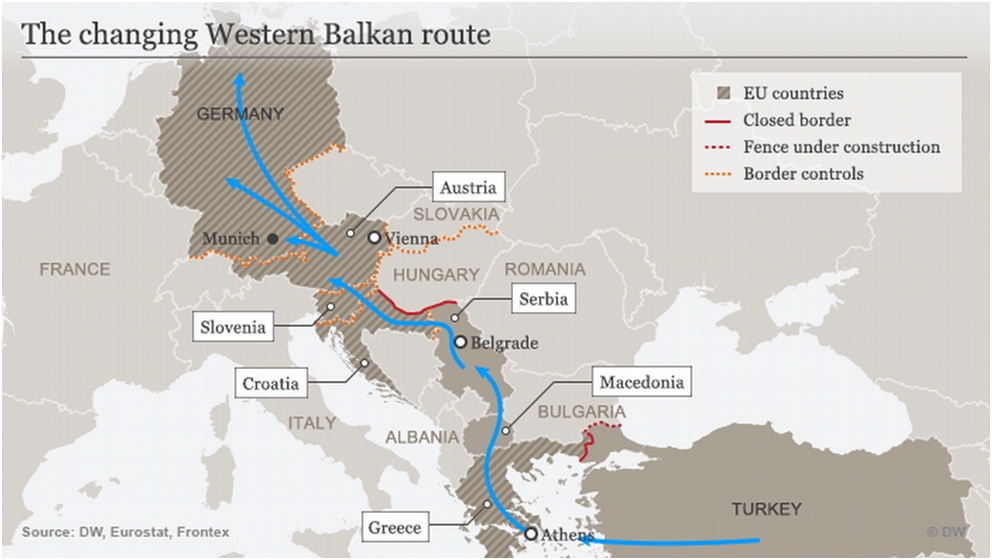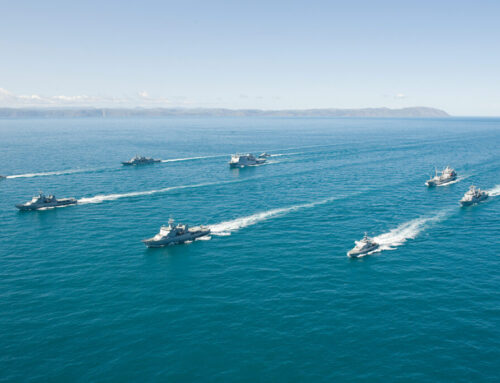Autor foto: Gémes Sándor/SzomSzed

The Balkans and the migration crisis
November 26, 2015
Author: Agata Biernat




Autor foto: Gémes Sándor/SzomSzed
The Balkans and the migration crisis
Author: Agata Biernat
Published: November 26, 2015
According to the latest report from Frontex, the EU border management agency, 710,000 immigrants crossed the borders of the European Union between January and the end of September 2015. Immigrants are trying to get into the EU using mainly two routes: the Mediterranean one and the Balkan one. The latter leads from Turkey via Greece, Macedonia, Serbia to Hungary and then on to Austria, Germany and Sweden. Some migrants from the Middle East also go to Serbia through Bulgaria, but this is still a rarely chosen route. The Balkan states have for several months been struggling with the problem of thousands of people illegally trying to cross their territory to reach EU countries. After the construction of the fence by the Hungarian authorities on the border with Serbia, another migration route began to lead through Croatia. The Office of the United Nations High Commissioner for Refugees (UNHCR) does not rule out the possibility that further routes may begin to run from Greece through Albania to Montenegro and Italy, and from Montenegro to Croatia by sea.
The Hungarian example and the domino effect
Hungary has had a significant influence on the policy of the Balkan countries towards illegal migrants. In June 2015, Hungarian authorities decided to close the border with Serbia and start to construct a fence. Viktor Orban’s government intends to take similar steps in relation to its other neighbours, Romania and Croatia (these countries are members of the EU, but do not belong to the Schengen area). Hungary also decided to tighten the rules on illegal border crossing. This policy has had the intended effect: the number of immigrants who manage to illegally get on the territory of Hungary has been decreasing. But at the same time it has contributed to increased tensions in the region.
| The East Mediterranean Trail [1] | The Balkan Trail | ||
| Country of origin | Number | Country of origin | Number |
| Syria | 248,810 | Syria | 88,149 |
| Afghanistan | 66,765 | Afghanistan | 52,995 |
| Irak | 18,884 | Kosovo | 23,547 |
| Total | 359,171 | Total | 204 630 |
Table 1. The number of people who crossed the Greek border illegally (January-September 2015). Source: Frontex, http://frontex.europa.eu/trends-and-routes/migratory-routes-map/[access: 29.10.2015].
The new Hungarian legislation brought protests from countries bordering with Hungary. Serbia has appealed to the government in Budapest to open the border. Serbia is one of those countries which is trying to cope with the wave of migrants without closing its borders. The authorities engaged various NGOs and humanitarian organizations to assist in this matter. Furthermore, they opened an information centre for newcomers, and banned anti-immigrant protests planned by far-right groups. It is estimated that in 2015 over 200,000 people crossed the territory of Serbia, which is 8.6 times more than in 2014. Most migrants are now in two camps located in the south of the country, near the border with Macedonia – in Preševo and Miratovac. The director of the Asylum Protection Centre (Serb. Centar za zaštitu i pomoć tražiocima azila), Rados Đurović, announced the creation of more places where migrants could temporarily stay, including in Bujanovac. Moreover, bearing in mind the possibility of increasing the number of people wishing to enter the territory of Serbia, the government is considering the creation of several smaller temporary camps in the cities of northern Serbia (i.e. Sombor, Kikinda, Kanjiža, Subotica and Šid).
Migration crisis and the deterioration of the Serbian-Croatian relations
Closing the Serbian-Hungarian border has resulted in an increased number of migrants heading to Croatia, where they could then enter Austria and Germany. Contrary to initial announcements, the Croatian government was not prepared for the arrival of such a number of immigrants. According to data published by the Ministry of Internal Affairs of Croatia, in just two days (between 16 and 18 September 2015) approximately 20,000 people entered Croatia. In order to cope with this problem, Croatia began to facilitate their movement from its own territory to the neighbouring countries, Slovenia and Hungary. At the same time the government in Zagreb has decided to close seven of the eight border crossings with Serbia in order to stop the influx of migrants. This decision was met with sharp criticism not only from Serbia, but also Slovenia and Hungary, which assumed that Croatia is unable to cope in an emergency situation, which affects its ability to join the Schengen area.
| 680400 | Refugees and migrants arriving by sea to Europe in 2015 as of 22 October. |
| 3150 | Refugees and migrants estimated to have died / gone missing at sea in 2015. |
| 537700 | Sea arrivals in Greece as of 22 October. |
| 8800 | Average daily sea arrivals in Greece from 16-22 October. |
| 139800 | Sea arrivals in Italy as of 22 October. |
| 47500 | Arrivals in Slovenia following closure of Hungary/Croatia border on 16 October. |
Table 2. The migration crisis in numbers. Source: Europe’s Refugee Emergency Response update #7 (16 – 22 October 2015), http://data.unhcr.org/mediterranean/documents.php?page=1& view=grid&Country[]=248, [access: 29.10.2015].
In turn, tightening of anti-Serb rhetoric in Croatia was associated with the parliamentary elections in the country, which took place on 8 November 2015. Recalling the difficult events, both for the Croatian and Serbian people from the time of the Second World War and the disintegration of Yugoslavia, intended to mobilise that part of the electorate that could determine the outcome of elections. Ultimately the Croatian Democratic Union (Hrvatska Demokratska Zajednica, HDZ) led by Tomislav Karamarko won, yielding 59 seats in the 151-seat parliament. The Social Democrats (Socijaldemokratska Partija Hrvatske SDP) won only three seats fewer. None of these parties, however, received the required majority for self-governing. Thus, who will form the future Croatian government, led by Milanović or Karamarko, will be determined by the new group, MOST, which unexpectedly won as many as 19 seats.
Macedonia, Albania, Montenegro and the migration crisis
Macedonia is yet another country which has to tackle the problem of immigrants. In July 2015 alone their number reached approximately 40,000 people. Initially, the government in Skopje sought to restrict the flow of migrants across the territory of Macedonia, including prohibiting them from the use of public transport. Such activities, however, did not produce a positive effect. Therefore, based on the steps Hungarian authorities took, Macedonia decided to start the construction of a fence on the border to reduce the number of people trying to enter illegally the territory of their country. A state of emergency was also announced, and the border with Greece was closed, which began to be controlled by the military. This resulted in riots among migrants.
One of the key reasons why Macedonia is not able to cope with the problem of immigrants is the lack of sufficient cooperation with its southern neighbour, Greece. It no longer controls the flow of migrants on its territory, making it easier for them to cross its borders. The Macedonian-Greek border is not adequately protected, and the Greek authorities, conflicted with the government in Skopje, were not interested in developing bilateral cooperation in this regard. Moreover, Greece still has not agreed to sign the Implementation Protocol to the readmission agreement with Macedonia.
Observing the situation in the region, both Montenegro and Albania are also trying to prepare for the possible arrival of immigrants. Montenegrin authorities are preparing an area near Podgorica where migrants could be received. Montenegrin experts estimate that Montenegro could receive 2,000 people a day. In contrast, Albania has established a working group at ministerial level in order to cope with the possible arrival of migrants. At the same time Bosnia and Herzegovina underlines the willingness to accept 5,000 people fleeing from the Middle East to Europe. It must be assumed, however, that like other Western Balkan states, it would not be able to cope with their sudden arrival (Bosnia does not have a strong central institutions or adequate infrastructure). Currently, migrants do not even choose Bosnia as a country of transit, through which they could freely penetrate further into the EU. The route of a possible pass through this country should be regarded as probably the longest and most dangerous one. On the territory of Bosnia there are still minefields, some of which are not even marked on the map.
Source: N. Rujevic, The Balkan route: A train passes through!, http://www.dw.com/en/the-balkan-route-a-train-passes-through/a-18809756, [dostęp: 29.10.2015].
The meeting of the EU and the Balkans
On October 25, 2015, the European Commission organised a special meeting in Brussels of the leaders of 11 countries of both the EU and the countries of the Western Balkans (Germany, Austria, Bulgaria, Croatia, Hungary, Romania, Greece, Slovenia, Serbia, Albania, Macedonia) regarding the migration crisis. As a conclusion of the meeting, a plan was adopted consisting of 17 points, aiming to slow down the movement of people through the region. The points include: refusal of access for migrants without prior agreement of the neighbouring countries; the creation of new, special checkpoints (on the Greek-Macedonian border and Greek-Albanian border); and sending 400 customs officials there who will be responsible for collecting personal data of people coming to Europe. In addition, Greece pledged to receive 50,000 people, and another 50,000 will be placed in various Balkan countries. At the same time it was stressed that all countries should ensure that all arriving people would receive shelter, medical care and food. The UNHCR would assist in these activities. Whereas financial assistance will be provided by the Council of Europe Development Bank, the European Investment Bank and the European Bank for Reconstruction and Development.
Recommendations
- In the first place the EU should help the Balkan countries in coping with the migration crisis not only financially, but also providing them with technical support. On one hand, it could consist in helping in the effective control of the movement of persons across borders, on the other conducting security checks, and then registering those immigrants who already arrived. The countries of the Western Balkans are still struggling with economic problems and the lack sufficient resources or implemented institutional mechanisms necessary to deal with the crisis. The tasks of the EU should also include ongoing monitoring of the situation in these countries to prevent the repeat in destabilisation of the region.
- The EU should find a way to include the Balkan countries in the decision-making process on a joint solution to the migration crisis. These countries have declared their wish to co-create European solidarity, and take their share of responsibility for this situation. The EU could also benefit from the experience of these countries in coping with the reception of refugees. They had to face this problem in the 1990s. Moreover, due to the fact that many citizens of Serbia, Croatia, Bosnia and Albania were forced in the past to leave their homelands, Balkan nations express empathy for the fate of refugees and the desire to help.
- Poland with its ambitions of being a leader in Central and Eastern Europe, should also make its policy in the Balkans more active in the context of attempts to solve the migration crisis. Poland, as a country responsible for safeguarding the EU’s eastern border, could share its knowledge and experience in this field. In the longer term this cooperation could also result in the development of mechanisms and procedures, which in the future would increase border protection across the European Union. The building of an EU migration policy is possible in the long term only when strict and uniform protection at the borders is established.
- Strengthening of the rhetoric referring to the past, based on recalling the events of the Second World War and the disintegration of Yugoslavia, which often divided the nations living in the Balkans, is a worrying phenomenon in the context of the migration crisis. It brings an increase in tensions in relations, both bilateral and multilateral, which also impacts the regional cooperation. Therefore, the EU in its policy towards the Western Balkans should place greater emphasis on strengthening of integration processes in the region. These countries have problems in the creation of multilateral cooperation. In this context, Poland could serve as an example to follow. As a member of the Weimar Triangle and the Visegrad Group, it has tried to deepen relations with those partners, with which it also shares a difficult history.
- Lack of leadership in the Union and the impossibility of developing a common position of member states is a bad example to the Balkans. The EU as a whole should be a role model for this region. Whereas inconsistent and unclear signals from individual EU countries (the UK, Germany and Central European countries) does not have a positive impact on strengthening cooperation in the Balkans. In the longer term, failure by the EU to develop a common solution to the current crisis may also translate into a drop in support for the EU among the Balkan countries who see ever more clearly the lack of effectiveness of the Union in dealing with emergencies.
Author: Agata Biernat, Research Fellow at the Casimir Pulaski Foundation
[1] According to the classification adopted by Frontex, the main migration routes leading to the EU include: West African trail, Western Mediterranean, Central Mediterranean trail leading through Apulia and Calabria and the one from the eastern border of the EU.






